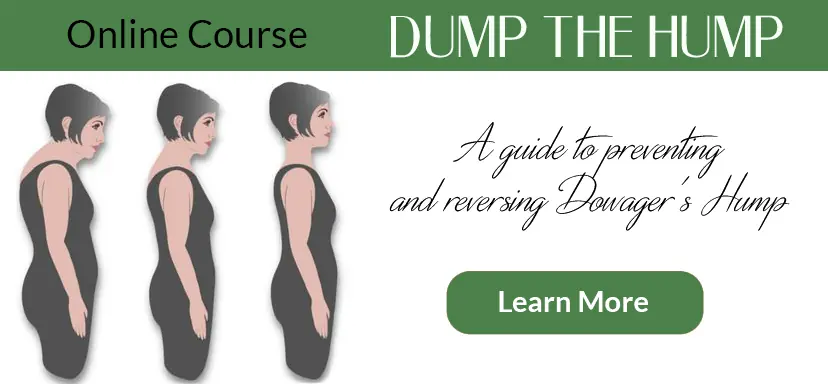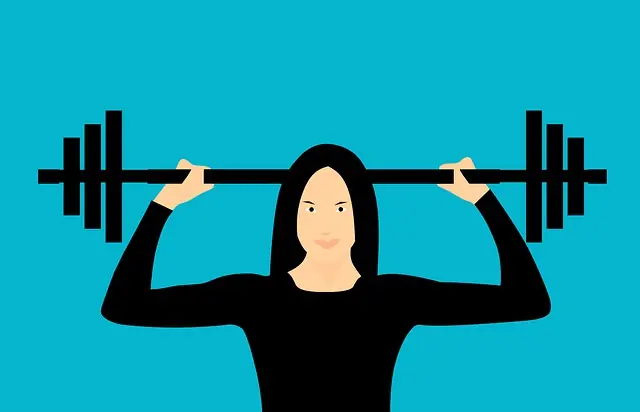Dowager’s Hump. You might know someone who has it. Your mother or grandmother may have suffered from it. You think you are developing one. Whatever your experience, direct or indirect, I am betting you have heard of this term and have seen women, and men, who walk hunched over and with difficulty; who struggle to get out of a chair, and who are unsteady on their feet. All indications of what scientists call age-related hyperkyphosis. Zooming to the end of the story, I have great news for how to prevent and reverse Dowager’s Hump!

Dowager's Hump Research
First, let’s look at the research on Dowager’s Hump (DH). A small amount of curvature in the thoracic or upper spine is normal because of the natural shape and curve of our vertebrates and discs which compose the structure of our spines. When our spines have a 40° or greater curve, we have Dowager’s Hump.
The degree of curvature can even be greater, with more serious consequences, and progress from 40° for women 40 years old and beyond, to an average of a 43° angle in women just postmenopausal (age 55 to 60), to a whopping 53° angle by the time we reach 76.
The most surprising news? Researchers found an unexpectedly high percentage (35%) of women age 20 to 60 already had the beginnings of Dowager’s Hump. Most interestingly, that stat is from 1993, well before our fingers, and our lives, became glued to a computer or cell phone. The number today? Closer to 65%, and climbing…
Causes of Dowager's Hump
Many of us believe DH is caused by “vertebral compression fractures.” Well, dispel that myth!
A mega-study encompassing all the major studies done on DH from 1955-2016, found fractures the culprit in just 30-40% of the cases.
Another belief brought up short by this study? Dowager’s Hump is a result of spinal osteoporosis. Again, not true.
Nor, has research found a direct link between Dowager’s Hump and calcium consumption, estrogen levels, or follicle-stimulating-hormone levels.
What about degenerative disc disease? Folks with hyperkyphosis do have higher incidents of degenerative disc disease, but it doesn’t seem that this is what causes Dowager’s Hump, but rather is a result of having it. Adding to the argument, the majority of those studied who had both Dowage’rs Hump and degenerative disc disease did not have previous vertebral fractures or osteoporosis, meaning if we do something about Dowager’s Hump, we can possibly prevent degenerative disc disease, as well. That works in my book!
Effects of Dowager's Hump
Let’s look at the result of Dowager’s Hump on our bodies and our life expectancy for a moment.
As our heads pitch forward, we experience a decline in our entire visual system. Then, our accurate reading of the world around us becomes compromised. Add in other age-related visual issues like cataracts and macular degeneration, and we become accidents waiting to happen.
Our mobility suffers, as well. We have trouble rising from a chair. We experience a loss of balance—also tied to our visual perceptions being skewed. We walk slower, we need more support for standing and walking, and our speed at climbing stairs declines—all of which double the chances of us falling and breaking a bone. In fact, the data points to Dowager’s Hump as one of the major factors contributing to falls among people over 60.
Increased pain in the back in 29% of the women studied was caused by loss of height due to increasing Dowager’s Hump, and more than 50% of adults who have lost height report having back pain. Interesting. Pain in the shoulders and pelvis, shorter pectoral and hip flexors resulting in pain in these areas, was noted, as well. Grip and ankle strength diminishes.
Our entire quality of life suffers. Last, the development of Dowager’s Hump shortens our lives by increasing the development of pulmonary disease and other frontal organ issues, and, with the increase in falls, death from fall-related developments.
Preventing or Reversing Dowager's Hump
Those of us experiencing Dowager’s Hump have difficulty reaching and doing anything more than light housework, and we score lower on overall physical activities and movement. What the new science now tells us is that we can do something about this.
Spine-strengthening exercises and postural training, specifically extension and thoracic strengthening work with resistance, done regularly, can both stop the development of Dowager’s Hump in its proverbial tracks, and even more encouraging, can reverse the severity of it in almost all cases. Flexion exercises—bending forward and rounding forward more often—increases our susceptibility to DH by more than 68%.
My last piece of data for today: several studies of women—who develop DH four times as often as men—found after thrice-weekly spine-strengthening extension exercises, saw a decrease in the angle of spine curvature by 11%.
To quote Wendy Katzman at the University of California San Francisco in the Journal of Orthopedic Sports Physical Therapy, “Kyphosis and forward head posture were significantly reduced among the compliant exercise group compared with the noncompliant group.”
The Mayo Clinic, from their study of postmenopausal women taking part in a back strengthening program, concluded, “Increasing the back extensor strength in healthy estrogen-deficient women helps decrease thoracic kyphosis.” The decrease in the angle of the spines of these women was, in their words, “significant.”
Until next time…Be Vibrant!




6 thoughts on “Reversing the Dreaded Dowager’s Hump”
What I find interesting in everything that I’m beginning to read about dowager hump, is that not one single clinician has mentioned what I believe, to bethe primary cause in women: we are constantly hunched over for years…chopping and cooking food, over the sink, diapering and playing or even talking with our children, sweeping, vacuuming etc. My university aged daughter pointed out to me one day that I’m getting “hunchy”. I never noticed amidst the busy-ness of life. I am horrified of how it looks at 58 so see the signs of “the old lady” emerging. I’m 5’10” and don’t know how I would have performed any of the above mentioned chores that sustained and nurtured my family without bending forward to do all of theses tasks repeatedly for years.
Thank you, Elaine. In fact, I am currently working on a class to help reverse and prevent Dowager’s Hump! Please sign up for my newsletter and you will be among the first to know about it when it launches.
Be Vibrant,
L.J.
What do you think of the osteostemgth computerized machine for strengthening bones?
I am not familiar with an osteostemgth computerized machine, but I will do some research and get back to you.
Be Vibrant,
LJ